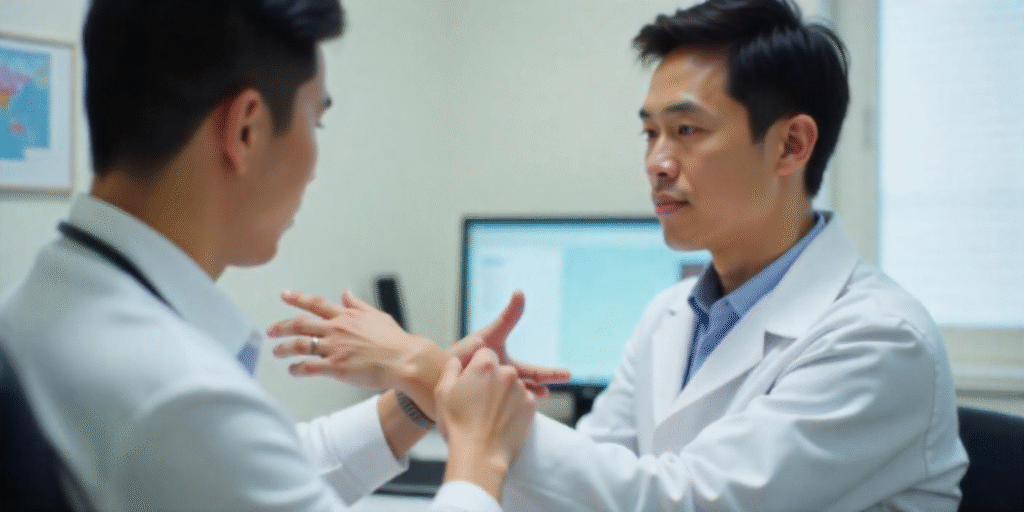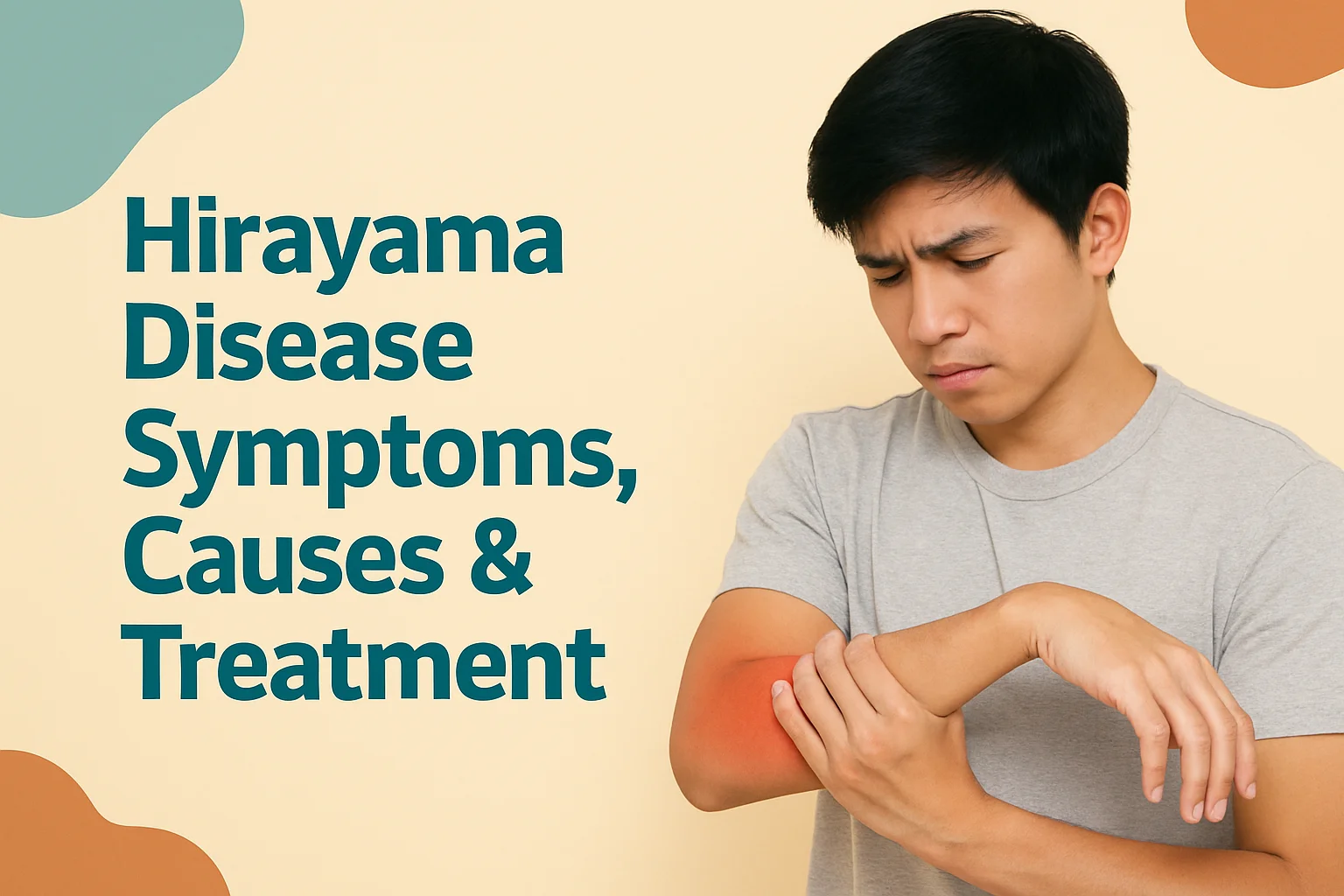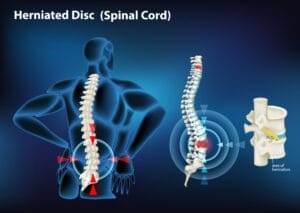Hirayama disease, also known in medical terms as monomelic amyotrophy, is a rare but significant neurological condition that affects the functioning of the muscles, primarily in the arms and hands. This disease is predominantly seen in young males, typically between the ages of 15 and 25, and often begins during adolescence. While the condition is not life threatening but it can lead to noticeable muscle weakness, loss of coordination and even long term functional limitations if not diagnosed early. Understanding the hirayama disease symptoms plays a crucial role in early intervention.
In this article, we’ll take a deep dive into the nature of the disease, explore what causes it, how it presents itself, the different treatment options available, and the overall life expectancy for individuals living with this condition. By the end, you’ll have a clear and simplified understanding of how to manage and live with Hirayama disease.
What Is Hirayama Disease?
Hirayama disease is a rare motor neuron disorder, primarily affecting the cervical (neck) portion of the spinal cord. What makes it different from other motor neuron diseases is its self-limiting nature—it progresses for a few years and then naturally stabilizes.
The disease is often characterized by a gradual onset of muscle weakness and atrophy (wasting) in one or both upper limbs, especially in the hands and forearms. This means that someone who was previously healthy might begin to notice weakness in their grip or have difficulty lifting objects with one hand. Recognizing these early hirayama disease symptoms can make a big difference in outcome.
Hirayama disease is most commonly observed in Asian countries like India, Japan and China, although cases have been reported globally. The earlier the condition is identified, the better the chances of preventing long-term disability.
Early Hirayama Disease Symptoms
Identifying the symptoms early on is extremely important especially because the symptoms can often be confused with general muscle fatigue or minor nerve injuries. Let us explore these initial warning signs in more detail:
1. Gradual Weakness in One Arm
The first and most common sign is a slow and progressive weakening in one arm usually the dominant one. This weakness can start with subtle symptoms like dropping objects or difficulty holding a pen, and can slowly worsen over several months.
2. Muscle Shrinkage (Atrophy)
As the muscles become weaker due to poor nerve function, they also start to shrink or waste away. You may observe visible thinning of the forearm and hand muscles. This is a very prominent hirayama disease symptom and should not be ignored.
3. Twitching of Muscles (Fasciculations)
Small, involuntary muscle movements under the skin, known as fasciculations, may occur. These muscle twitches often go unnoticed initially but become more frequent as the disease progresses.
4. Cold Sensitivity and Increased Weakness
Another unique symptom of Hirayama disease is increased weakness in cold temperatures. Many patients report their affected hand feeling stiffer or weaker during winter or while handling cold objects.
5. No Sensory Loss
Interestingly, one defining feature of Hirayama disease is that while motor function is affected but sensory nerves are not. This means patients will not experience numbness, tingling or loss of sensation, helping doctors differentiate it from other nerve related conditions.
If these hirayama disease symptoms are observed especially in a young male, it is critical to consult a neurologist for a proper diagnosis.
Advanced Hirayama Disease Symptoms
If left undiagnosed and untreated, the disease can progress over the first 3 to 5 years before naturally stabilizing. During this period, the following hirayama disease symptoms may become more severe and noticeable:
- Increased difficulty with fine motor tasks, such as buttoning a shirt, tying shoelaces, or writing. Everyday activities become frustrating due to the loss of hand coordination.
- Noticeable difference in muscle size between the two arms, often leading to cosmetic concerns and self-consciousness.
- Claw-like deformity of the hand due to uneven muscle wasting and imbalance in muscle strength.
- Loss of grip strength, making it difficult to hold objects for extended periods.
- Mild tremors or shaky hand movements, particularly when trying to perform delicate tasks.
Though the progression slows after a few years, these advanced hirayama disease symptoms can leave a lasting impact, especially if the condition goes untreated during its active phase.
What Are the Causes of Hirayama Disease?
Hirayama disease causes are not yet fully understood, but most researchers agree that it is related to abnormal spinal cord compression during neck flexion (bending the neck forward).
Let’s break down the main suspected causes:
- Forward shifting of the spinal cord during neck flexion is believed to cause repeated injury to the lower motor neurons in the cervical spine. This mechanical stress damages the anterior horns, leading to muscle weakness.
- Narrow spinal canal (tight dural sac) is another major factor. In patients with Hirayama disease, the protective covering of the spinal cord doesn’t stretch enough, leading to pinching of the cord when the neck is bent.
- Poor blood supply to spinal neurons, especially during neck movement, is also believed to contribute to neuron damage and muscle degeneration.
Although the exact hirayama disease causes are still being studied, these structural and mechanical issues appear to play a major role in disease development.
How Is Hirayama Disease Diagnosed?

Because the hirayama disease symptoms can closely resemble other neurological disorders, a detailed and thorough diagnostic approach is necessary.
1. Clinical Neurological Examination
A trained neurologist will first examine the patient’s muscle strength, reflexes, and any signs of muscle wasting. The absence of sensory loss also gives a clue toward Hirayama disease.
2. Electromyography (EMG)
This test measures how well the muscles and nerves are functioning. EMG results often show chronic denervation in the affected muscles confirming motor neuron involvement.
3. MRI with Neck Flexion
This is the most crucial diagnostic tool. When the MRI is taken with the neck in a flexed position, it shows the forward movement of the spinal cord, spinal cord flattening, or congestion of veins—all classic signs of Hirayama disease.
4. Nerve Conduction Studies
These tests help to differentiate Hirayama disease from peripheral nerve injuries or other neuromuscular conditions.
A prompt and accurate diagnosis not only helps confirm the presence of hirayama disease symptoms but also sets the stage for timely treatment.
Treatment Options for Hirayama Disease
Although there is no permanent cure yet but several hirayama disease treatment methods can help manage the symptoms effectively and prevent long term disability.
1. Cervical Collar
Wearing a cervical collar is the first line and most effective treatment. The collar prevents the neck from bending forward thereby reducing the spinal cord compression and stopping disease progression. Patients are typically advised to wear it for 12–18 months.
2. Physiotherapy and Rehabilitation
Customized physical therapy exercises help maintain mobility and improve muscle strength. It also helps in training unaffected muscles to compensate for the weak ones improving overall hand function.
3. Occupational Therapy
This therapy helps patients adapt to daily tasks and improve fine motor skills. It focuses on enhancing independence in day to day activities.
4. Surgical Intervention
In very rare and severe cases, where the condition progresses rapidly or does not respond to conservative methods, surgical decompression or spinal fusion may be recommended. This is typically a last resort in hirayama disease treatment.
The effectiveness of these treatments depends on how early the hirayama disease symptoms are identified and how consistently the treatment plan is followed.
Also Read: PIVD Symptoms
Lifestyle Changes and Daily Management
Managing Hirayama disease goes beyond medical treatment. Patients must make lifestyle adjustments to maintain quality of life:
- Avoid excessive neck bending especially during reading, studying or screen time.
- Use ergonomic furniture to support proper posture while working or studying.
- Keep your hands warm, particularly during cold weather to prevent symptom flare-ups.
- Follow up regularly with your neurologist to track any progression or need for treatment changes.
- Perform exercises under supervision, avoiding strain on affected muscles.
Making these changes can significantly reduce the impact of hirayama disease symptoms in everyday life.
Hirayama Disease Life Expectancy
One of the most reassuring facts about Hirayama disease is that it does not shorten lifespan. Hirayama disease life expectancy is considered normal. The condition is self-limiting, meaning it worsens only during the early years and then stabilizes naturally.
However, the quality of life may be affected, depending on the severity of symptoms and how early they are managed. With timely diagnosis, proper treatment and consistent monitoring, most individuals can live healthy and functional lives with minor limitations.
Also Read: Ways to Boost Immune System
Real Life Example: Living with Hirayama Disease
Take the case of Rahul a 20 year old college student from Bengaluru. He began experiencing weakness in his right hand, making it hard for him to take notes or lift objects. His parents initially thought it was due to excessive use of his mobile phone. But after a neurologist recommended an MRI with neck flexion, he was diagnosed with Hirayama disease.
Rahul began wearing a cervical collar, underwent regular physiotherapy, and modified his study posture. Within 18 months, his condition stabilized, and he’s now completing his degree with minimal issues. His story is a strong reminder that early attention to hirayama disease symptoms can make all the difference.
Conclusion
Hirayama disease may be rare but awareness is the first step toward effective management. From early Hirayama disease symptoms like hand weakness and muscle atrophy to long term strategies like wearing a cervical collar and undergoing physical therapy this condition is manageable with the right approach.
The key is early diagnosis and commitment to lifestyle adaptations. Whether you’re experiencing symptoms or supporting someone who is, knowing about Hirayama disease causes, treatment options and life expectancy helps in making informed decisions.
Frequently Asked Questions
1. What age group is commonly affected by Hirayama disease?
It mostly affects adolescent and young adult males, typically between the ages of 15 and 25. Early symptoms usually appear during late teens.
2. Is Hirayama disease a permanent condition?
The condition progresses for a few years and then stabilizes on its own. With timely management, symptoms can be controlled effectively.
3. Can both arms be affected?
Yes, although it usually starts in one arm, the other arm may also be affected in some cases, often to a lesser extent.
4. Is surgery necessary for Hirayama disease treatment?
Surgery is rarely needed and is only considered in severe or rapidly progressing cases. Most people improve with conservative treatment.
5. Can people with Hirayama disease lead a normal life?
Yes, with early diagnosis and proper care, most individuals continue daily activities and careers with minimal limitations.




